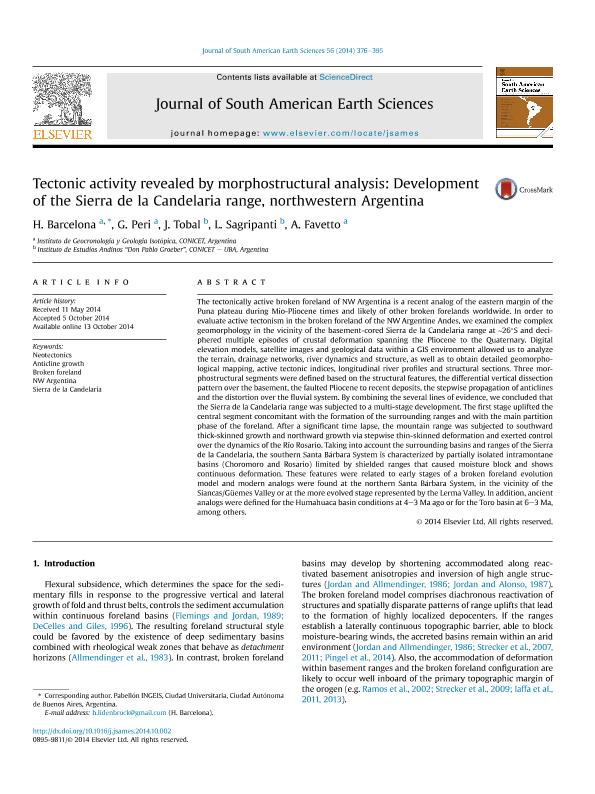Mostrar el registro sencillo del ítem
dc.contributor.author
Barcelona, Hernan

dc.contributor.author
Peri, Verónica Gisel

dc.contributor.author
Tobal, Jonathan Elías

dc.contributor.author
Sagripanti, Lucía

dc.contributor.author
Favetto, Alicia Beatriz

dc.date.available
2018-01-16T18:06:16Z
dc.date.issued
2014-10
dc.identifier.citation
Barcelona, Hernan; Sagripanti, Lucía; Tobal, Jonathan Elías; Peri, Verónica Gisel; Favetto, Alicia Beatriz; Tectonic activity revealed by morphostructural analysis: Development of the Sierra de la Candelaria range, northwestern Argentina; Elsevier; Journal of South American Earth Sciences; 56; 10-2014; 376-395
dc.identifier.issn
0895-9811
dc.identifier.uri
http://hdl.handle.net/11336/33443
dc.description.abstract
The tectonically active broken foreland of NW Argentina is a recent analog of the eastern margin of the Puna plateau during Mio-Pliocene times and likely of other broken forelands worldwide. In order to evaluate active tectonism in the broken foreland of the NW Argentine Andes, we examined the complex geomorphology in the vicinity of the basement-cored Sierra de la Candelaria range at ∼26°S and deciphered multiple episodes of crustal deformation spanning the Pliocene to the Quaternary. Digital elevation models, satellite images and geological data within a GIS environment allowed us to analyze the terrain, drainage networks, river dynamics and structure, as well as to obtain detailed geomorphological mapping, active tectonic indices, longitudinal river profiles and structural sections. Three morphostructural segments were defined based on the structural features, the differential vertical dissection pattern over the basement, the faulted Pliocene to recent deposits, the stepwise propagation of anticlines and the distortion over the fluvial system. By combining the several lines of evidence, we concluded that the Sierra de la Candelaria range was subjected to a multi-stage development. The first stage uplifted the central segment concomitant with the formation of the surrounding ranges and with the main partition phase of the foreland. After a significant time lapse, the mountain range was subjected to southward thick-skinned growth and northward growth via stepwise thin-skinned deformation and exerted control over the dynamics of the Río Rosario. Taking into account the surrounding basins and ranges of the Sierra de la Candelaria, the southern Santa Bárbara System is characterized by partially isolated intramontane basins (Choromoro and Rosario) limited by shielded ranges that caused moisture block and shows continuous deformation. These features were related to early stages of a broken foreland evolution model and modern analogs were found at the northern Santa Bárbara System, in the vicinity of the Siancas/Güemes Valley or at the more evolved stage represented by the Lerma Valley. In addition, ancient analogs were defined for the Humahuaca basin conditions at 4–3 Ma ago or for the Toro basin at 6–3 Ma, among others.
dc.format
application/pdf
dc.language.iso
eng
dc.publisher
Elsevier

dc.rights
info:eu-repo/semantics/openAccess
dc.rights.uri
https://creativecommons.org/licenses/by-nc-nd/2.5/ar/
dc.subject
Neotectonics
dc.subject
Anticline Growth
dc.subject
Broken Foreland
dc.subject
Sierra de La Candelaria
dc.subject.classification
Meteorología y Ciencias Atmosféricas

dc.subject.classification
Ciencias de la Tierra y relacionadas con el Medio Ambiente

dc.subject.classification
CIENCIAS NATURALES Y EXACTAS

dc.title
Tectonic activity revealed by morphostructural analysis: Development of the Sierra de la Candelaria range, northwestern Argentina
dc.type
info:eu-repo/semantics/article
dc.type
info:ar-repo/semantics/artículo
dc.type
info:eu-repo/semantics/publishedVersion
dc.date.updated
2018-01-12T19:49:42Z
dc.journal.volume
56
dc.journal.pagination
376-395
dc.journal.pais
Países Bajos

dc.journal.ciudad
Amsterdam
dc.description.fil
Fil: Barcelona, Hernan. Consejo Nacional de Investigaciones Científicas y Técnicas. Oficina de Coordinación Administrativa Ciudad Universitaria. Instituto de Geocronología y Geología Isotopica. Universidad de Buenos Aires. Facultad de Ciencias Exactas y Naturales. Instituto de Geocronología y Geología Isotópica; Argentina
dc.description.fil
Fil: Peri, Verónica Gisel. Consejo Nacional de Investigaciones Científicas y Técnicas. Oficina de Coordinación Administrativa Ciudad Universitaria. Instituto de Geocronología y Geología Isotopica. Universidad de Buenos Aires. Facultad de Ciencias Exactas y Naturales. Instituto de Geocronología y Geología Isotópica; Argentina
dc.description.fil
Fil: Tobal, Jonathan Elías. Consejo Nacional de Investigaciones Científicas y Técnicas. Oficina de Coordinación Administrativa Ciudad Universitaria. Instituto de Estudios Andinos "Don Pablo Groeber". Universidad de Buenos Aires. Facultad de Ciencias Exactas y Naturales. Instituto de Estudios Andinos "Don Pablo Groeber"; Argentina
dc.description.fil
Fil: Sagripanti, Lucía. Consejo Nacional de Investigaciones Científicas y Técnicas. Oficina de Coordinación Administrativa Ciudad Universitaria. Instituto de Estudios Andinos "Don Pablo Groeber". Universidad de Buenos Aires. Facultad de Ciencias Exactas y Naturales. Instituto de Estudios Andinos "Don Pablo Groeber"; Argentina
dc.description.fil
Fil: Favetto, Alicia Beatriz. Consejo Nacional de Investigaciones Científicas y Técnicas. Oficina de Coordinación Administrativa Ciudad Universitaria. Instituto de Geocronología y Geología Isotopica. Universidad de Buenos Aires. Facultad de Ciencias Exactas y Naturales. Instituto de Geocronología y Geología Isotópica; Argentina
dc.journal.title
Journal of South American Earth Sciences

dc.relation.alternativeid
info:eu-repo/semantics/altIdentifier/url/http://www.sciencedirect.com/science/article/pii/S0895981114001382
dc.relation.alternativeid
info:eu-repo/semantics/altIdentifier/doi/http://dx.doi.org/10.1016/j.jsames.2014.10.002
Archivos asociados
